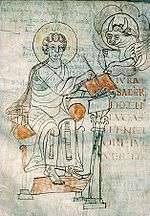Merovingian illumination
Merovingian illumination is the term for the continental Frankish style of illumination in the late seventh and eight centuries, named for the Merovingian dynasty. Ornamental in form, the style consists of initials constructed from lines and circles based on Late Antique illumination, title pages with arcades and crucifixes. Figural images were almost totally absent. From the eight century, zoomorphic decoration began to appear and become so dominant that in some manuscripts from Chelles whole pages are made up of letters formed from animals. Unlike the contemporary Insular illumination with its rampant decoration, the Merovingian style aims for a clean page.
One of the oldest and most productive scriptoria was Luxeuil Abbey, founded by the Irish monk Columbanus in 590 and destroyed in 732. Corbie Abbey, founded in 662, developed its own version of the style, while Chelles and Laon were further centres. From the middle of the eighth century, Merovingian illumination was strongly influenced by insular illumination. An evangeliary from Echternach (Trier, Dombibliothek, Cod. 61 olim 134.) indicates that it came into the abbey as the collaborative work of Irish and Merovingian scribes. The foundation of Willibrord strongly influenced continental illumination and led to the brought Irish culture into the Merovingian realm.
Examples
| Image | Name | Date | Location, school | Contents, significance | Inventory number |
 |
Sélestat Lectionary | c.700 | Humanist Library of Sélestat | ||
 |
Gelasian Sacramentary | c.750 | Sacramentary | Rome, Vatican Library, Reg. Lat. 316 | |
 |
c.750 | East West Francia (Burgundy?) | Bible | Autun, Bibliothèque Municipale, Ms 2 | |
 |
Gundohinus Gospels | 754/755 | Vosevio Abbey (location unknown), East West Francia, possibly Burgundy | Evangeliary | Autun, Bibliothèque Municipale. Ms 3 |
 |
c.780 | Saint-Pierre de Flavigny (east West Francia) | Autun, Bibliothèque Municipale. Ms 5 | ||
 |
Sacramentary of Gellone | End of the eighth century | Meaux | Sakramentar | Paris, Bibliothèque Nationale, Lat. 12048 |
 |
End of the eighth century | Burgundy | Evangeliary for the use of Saint-Pierre de Flavigny (Burgundy) | Autun, Bibliothèque Municipale. Ms 4 | |
Bibliography
| Wikimedia Commons has media related to Merovingian manuscripts. |
- Kunibert Bering: Kunst des frühen Mittelalters. 2nd revised edition. Reclam, Stuttgart 2008, ISBN 978-3-15-018169-0, (Kunst-Epochen. 2) (Reclams Universal-Bibliothek. 18169).
- Ernst Günther Grimme: Die Geschichte der abendländischen Buchmalerei. 3rd Edition. Köln, DuMont 1988. ISBN 3-7701-1076-5.
- Christine Jakobi-Mirwald: Das mittelalterliche Buch. Funktion und Ausstattung. Stuttgart, Reclam 2004. ISBN 978-3-15-018315-1, (Reclams Universal-Bibliothek 18315), (Besonders Kapitel Geschichte der europäischen Buchmalerei S. 222–278).
- Buchmalerei. In Severin Corsten / Günther Pflug / Friedrich Adolf Schmidt-Künsemüller (Edd.): Lexikon des Mittelalters 2: Bettlerwesen bis Codex von Valencia. Lizenzausgabe. Unveränderter Nachdruck der Studienausgabe 1999. Wissenschaftliche Buchgesellschaft, Darmstadt 2009, ISBN 978-3-534-22804-1, pp. 837-893, (Contributions by K. Bierbrauer, Ø. Hjort, O. Mazal, D. Thoss, G. Dogaer, J. Backhouse, G. Dalli Regoli, H. Künzl).
- Otto Pächt: Buchmalerei des Mittelalters. Eine Einführung. Edited by Dagmar Thoss. 5th Edition. Prestel, München 2004. ISBN 978-3-7913-2455-5.
- Ingo F. Walther / Norbert Wolf: Codices illustres. Die schönsten illuminierten Handschriften der Welt. Meisterwerke der Buchmalerei. 400 bis 1600. Taschen, Köln etc. 2005, ISBN 3-8228-4747-X.